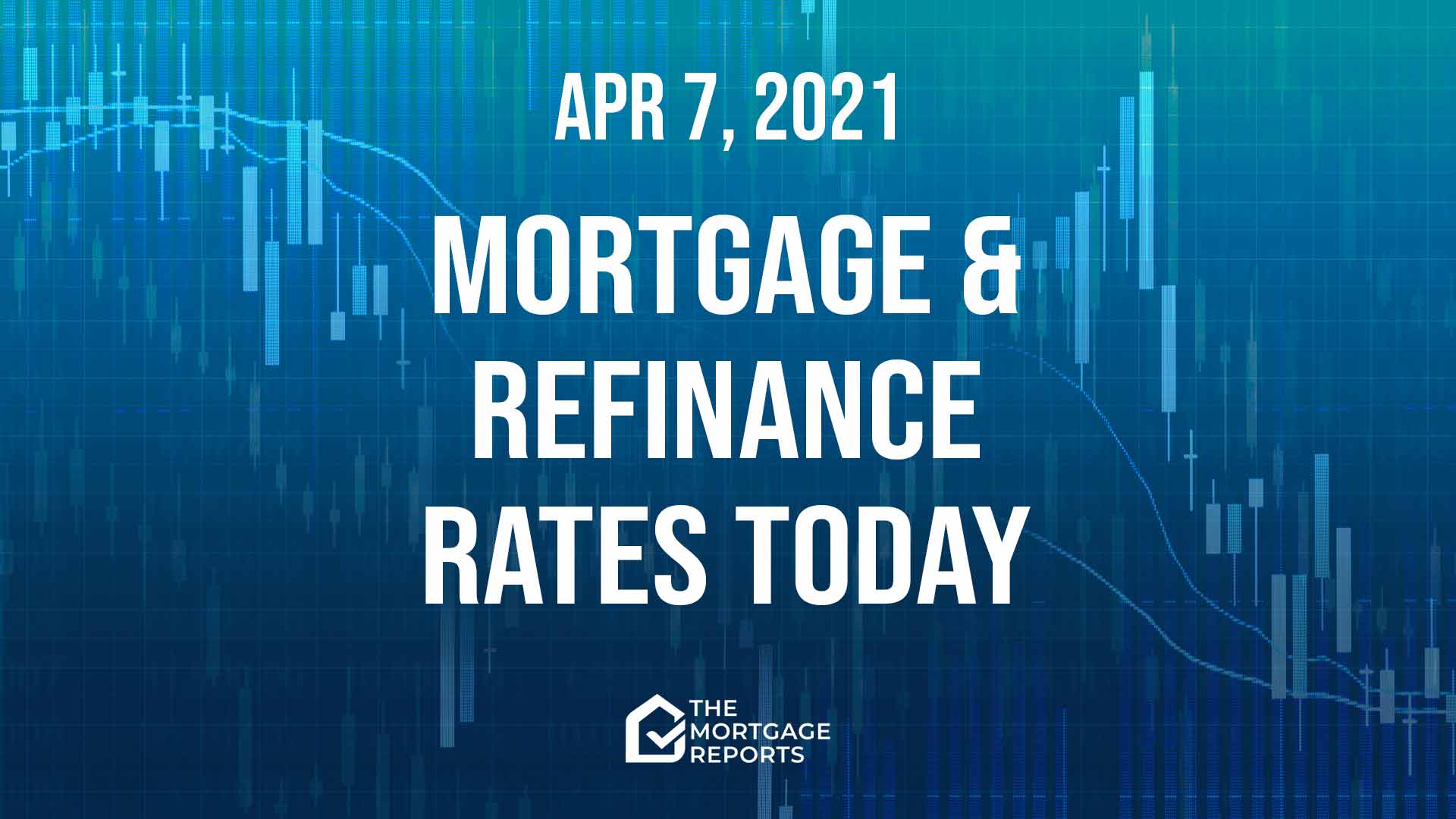
Today’s mortgage and refinance rates
Average mortgage rates fell moderately yesterday, as we predicted. It’s been nearly a week since we’ve seen a rise.
And that happy run may continue today. Because, first thing this morning, it was looking as if mortgage rates today might hold steady or fall modestly. However, the Federal Reserve is due early this afternoon to release the minutes of its latest key policy meeting. And those could change everything.
Find and lock a low rate (Apr 7th, 2021)Current mortgage and refinance rates
| Program | Mortgage Rate | APR* | Change |
|---|---|---|---|
| Conventional 30 year fixed | |||
| Conventional 30 year fixed | 3.132% | 3.137% | -0.11% |
| Conventional 15 year fixed | |||
| Conventional 15 year fixed | 2.406% | 2.524% | -0.1% |
| Conventional 20 year fixed | |||
| Conventional 20 year fixed | 2.875% | 2.967% | -0.03% |
| Conventional 10 year fixed | |||
| Conventional 10 year fixed | 1.982% | 2.207% | -0.01% |
| 30 year fixed FHA | |||
| 30 year fixed FHA | 2.936% | 3.598% | -0.01% |
| 15 year fixed FHA | |||
| 15 year fixed FHA | 2.707% | 3.293% | -0.02% |
| 5 year ARM FHA | |||
| 5 year ARM FHA | 2.5% | 3.207% | Unchanged |
| 30 year fixed VA | |||
| 30 year fixed VA | 2.5% | 2.674% | -0.09% |
| 15 year fixed VA | |||
| 15 year fixed VA | 2.346% | 2.668% | -0.03% |
| 5 year ARM VA | |||
| 5 year ARM VA | 2.5% | 2.386% | Unchanged |
| Rates are provided by our partner network, and may not reflect the market. Your rate might be different. Click here for a personalized rate quote. See our rate assumptions here. | |||
COVID-19 mortgage updates: Mortgage lenders are changing rates and rules due to COVID-19. To see the latest on how coronavirus could impact your home loan, click here.
Should you lock a mortgage rate today?
If you just looked at mortgage rates so far in April and on the last day of March, you’d think we were in the midst of a downward trend. But all the falls we’ve seen in that period don’t add up to the rises between March 28-30. And, if you glance back to this time last month, those rates are appreciably higher now.
So, to me, it seems unlikely that the upward trend is yet reversing — or is going to anytime soon. But it’s undeniable that this pause in rises was unanticipated (by me, anyway). And that investors currently seem to be acting tactically. (Read on for more.)
Still, my personal rate lock recommendations remain:
- LOCK if closing in 7 days
- LOCK if closing in 15 days
- LOCK if closing in 30 days
- LOCK if closing in 45 days
- LOCK if closing in 60 days
But I don’t claim perfect foresight. And your personal analysis could turn out to be as good as mine — or better. So you might choose to be guided by your instincts and your personal tolerance for risk.
Market data affecting today’s mortgage rates
Here’s a snapshot of the state of play this morning at about 9:50 a.m. (ET). The data, compared with roughly the same time yesterday, were:
- The yield on 10-year Treasurys edged lower to 1.66% from 1.68% (Good for mortgage rates.) More than any other market, mortgage rates normally tend to follow these particular Treasury bond yields, though less so recently
- Major stock indexes were mostly higher on opening. (Bad for mortgage rates.) When investors are buying shares they’re often selling bonds, which pushes prices of those down and increases yields and mortgage rates. The opposite happens when indexes are lower
- Oil prices fell to $59.14 from $60.20 a barrel. (Good for mortgage rates*.) Energy prices play a large role in creating inflation and also point to future economic activity.)
- Gold prices inched lower to $1,738 from $1,740 an ounce. (Neutral for mortgage rates*.) In general, it’s better for rates when gold rises, and worse when gold falls. Gold tends to rise when investors worry about the economy. And worried investors tend to push rates lower
- CNN Business Fear & Greed index — Nudged down to 63 from 64 out of 100. (Good for mortgage rates.) “Greedy” investors push bond prices down (and interest rates up) as they leave the bond market and move into stocks, while “fearful” investors do the opposite. So lower readings are better than higher ones
Caveats about markets and rates
Before the pandemic and the Federal Reserve’s interventions in the mortgage market, you could look at the above figures and make a pretty good guess about what would happen to mortgage rates that day. But that’s no longer the case. We still make daily calls. And are usually right. But our record for accuracy won’t achieve its former high levels until things settle down.
So use markets only as a rough guide. Because they have to be exceptionally strong or weak to rely on them. But, with that caveat, so far mortgage rates today look likely to fall modestly or hold steady. Just be aware that intraday swings (when rates change direction during the day) are a common feature right now.
Find and lock a low rate (Apr 7th, 2021)
Important notes on today’s mortgage rates
Here are some things you need to know:
- Typically, mortgage rates go up when the economy’s doing well and down when it’s in trouble. But there are exceptions. Read ‘How mortgage rates are determined and why you should care‘
- Only “top-tier” borrowers (with stellar credit scores, big down payments and very healthy finances) get the ultralow mortgage rates you’ll see advertised
- Lenders vary. Yours may or may not follow the crowd when it comes to daily rate movements — though they all usually follow the wider trend over time
- When daily rate changes are small, some lenders will adjust closing costs and leave their rate cards the same
- Refinance rates are typically close to those for purchases. But some types of refinances are higher following a regulatory change
So there’s a lot going on here. And nobody can claim to know with certainty what’s going to happen to mortgage rates in coming hours, days, weeks, or months.
Are mortgage and refinance rates rising or falling?
Today and soon
Should I be revising my belief that mortgage rates are going to carry on rising now that they’re falling? Not yet. Lulls and brief periods when stocks, commodities or yields and rates move against a trend are features of all markets.
And the basic driver of upward movement (evidence of an imminent economic boom) grows in strength daily. Just yesterday, the official February job openings and labor turnover survey (JOLTS) figures reached a record high — in spite of that month’s freak weather. And the March Institute for Supply Management’s (ISM’s) index for the services sector — also out that day — achieved a new all-time high, too.
The sort of growth these and other recent figures imply pretty much invariably brings higher mortgage rates. But it also usually brings inflation.
And this morning’s Financial Times ran the headline, “US inflation fears grow as bond turmoil continues.” In the report that followed, it quoted a bond trader: “I’m staying away from conventional fixed income for fear of rising yields.”
Over time, such fears of future inflation tend to bring higher rates. But, right now, it seems to be lowering them. I doubt that will last. And I wonder whether the Federal Reserve is buying extra mortgage-backed securities to keep these rates artificially low for now.
Of course, my reading of the situation may be proved wrong. And, even if I’m right, it’s perfectly possible that some cataclysmic event will send mortgage rates tumbling. But how likely is that? I wouldn’t wager my next mortgage rate with those odds — especially with the likely meager winnings currently on the table.
For more background on my wider thinking, read our latest weekend edition, which is published every Saturday soon after 10 a.m. (ET).
Recently
Over much of 2020, the overall trend for mortgage rates was clearly downward. And a new, weekly all-time low was set on 16 occasions last year, according to Freddie Mac.
The most recent weekly record low occurred on Jan. 7, when it stood at 2.65% for 30-year fixed-rate mortgages. But then the trend reversed and rates rose. And Freddie’s Apr. 1 report puts that weekly average at 3.18% (with 0.7 fees and points), up from the previous week’s 3.17%.
Expert mortgage rate forecasts
Looking further ahead, Fannie Mae, Freddie Mac and the Mortgage Bankers Association (MBA) each has a team of economists dedicated to monitoring and forecasting what will happen to the economy, the housing sector and mortgage rates.
And here are their current rates forecasts for the remaining quarters of 2021 (Q2/21, Q3/21, Q4/21) and the first quarter of 2022 (Q1/22).
The numbers in the table below are for 30-year, fixed-rate mortgages. Fannie’s were updated on March 17 and the MBA’s on March 22. But Freddie now publishes forecasts quarterly. Its figures are from Jan. 10 and are looking distinctly stale:
| Forecaster | Q2/21 | Q3/21 | Q4/21 | Q1/22 |
| Fannie Mae | 3.1% | 3.1% | 3.2% | 3.3% |
| Freddie Mac | 3.0% | 3.0% | 3.0% | N/A |
| MBA | 3.2% | 3.4% | 3.6% | 3.7% |
However, given so many unknowables, the current crop of forecasts might be even more speculative than usual. And there’s certainly a widening spread as the year progresses.
Find your lowest rate today
Some lenders have been spooked by the pandemic. And they’re restricting their offerings to just the most vanilla-flavored mortgages and refinances.
But others remain brave. And you can still probably find the cash-out refinance, investment mortgage or jumbo loan you want. You just have to shop around more widely.
But, of course, you should be comparison shopping widely, no matter what sort of mortgage you want. As federal regulator the Consumer Financial Protection Bureau says:
Verify your new rate (Apr 7th, 2021)Shopping around for your mortgage has the potential to lead to real savings. It may not sound like much, but saving even a quarter of a point in interest on your mortgage saves you thousands of dollars over the life of your loan.



